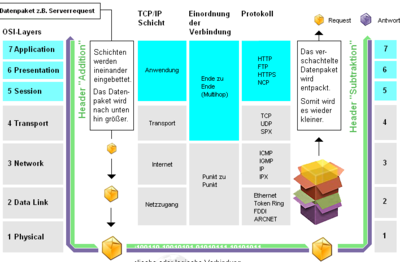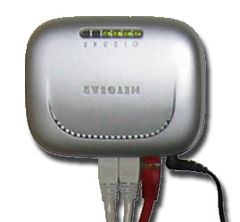Difference between revisions of "Network Basics and Network Abstraction in Linux"
(→Layer 2) |
(→Network Abstraction in Linux) |
||
| Line 37: | Line 37: | ||
== Network Abstraction in Linux == |
== Network Abstraction in Linux == |
||
| + | |||
| + | If we use a network card of a different vendor we do not want to rewrite all our programs. So the Linux system has drivers for all different network cards and once the right drivers are installed we do not have to care about the particularities of each card. We only see a <q>network interface</q>. For the most part we also do not want to care about the details of sending packets, re-transmitting those that are lost, etc.. - we just want a connection to youtube.com to watch funny hamsters dancing. |
||
Revision as of 15:21, 24 March 2020
Motivation
Before you learn the tools and commands for using the network in Linux you need a basic understanding of how networks work and this unit tries to bring you up to speed quickly.
The ISO-OSI 7 Layer Model
The 7 Layer Model is used to describe networks. The IP Protocol has not been developed within ISO and thus only roughly fits into the mode. Still it is a good picture to have in you mind when you think about networks.
On Top you have your applications. Like e.g. a Web-Browser. Below you need definitions on the details of how websites are encoded and transported via HTTP. And so on. And at the bottom we need specifications on how data is transmitted at the wire (or wireless): E.g. cable definitions, voltage levels, frequency, etc..
What we are looking at here is the Layer 2: That defines how data is encoded on a certain medium and in later units also layer3 (Routing - how packets are sent between networks).
Layer 2
From the abstraction in the operating system we basically have 2 different kind of physical medium:
- broadcast
- There is a local network where stations can send to each other and also there is a way to send to all stations on the network. Typically an ethernet network segment or a WiFi network.
- point-to-Point
- Two stations connected via a link and only those 2 stations can exchange data. Typically a dial-up connection, a network over a serial line or a virtual connection like a VPN tunnel.
The typical broadcast medium is ethernet
and most network interfaces are of this type. In ethernet you have a 6 byte address that is used to address each station on the network. This is the so called hardware address
or MAC Address
. It is usually written in the form of 12 hex digits grouped into bytes by colons. E.g.: b0:35:9f:2a:29:7d. Each network card should have a unique MAC address. The first digits are assigned to a company and the last digits are counted up in the factory. The address mentioned belongs to an intel card.
In the old days the ethernet was built with a coaxial-cable that connected all computers. Today ethernet is usually built with twisted pair cables and RJ45 connectors. The cables run to a central switch or hub that distributes the packages to all stations. A hub would distribute every packet to every station. A switch is more intelligent: It learns the MAC address of each station and only distributes packets to the computer that was address. Of course, broadcasts are always sent to all station on that segment.
Most of the time we want to send TCP/IP packages. Those are encoded as payload within the ethernet frame. Within the TCP/IP there could be e.g. an HTTP request.
With IP we are already moving to layer 3.
Network Abstraction in Linux
If we use a network card of a different vendor we do not want to rewrite all our programs. So the Linux system has drivers for all different network cards and once the right drivers are installed we do not have to care about the particularities of each card. We only see a network interface
. For the most part we also do not want to care about the details of sending packets, re-transmitting those that are lost, etc.. - we just want a connection to youtube.com to watch funny hamsters dancing.


